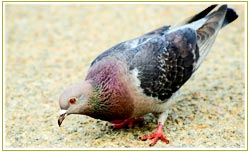About The Pigeon
 The Pigeon or Rock Dove, first brought into Northern America in the 1600s, can be quite common in urban locations all around the world. Rocky mountain cliffs are the wild Pigeons’ natural habitat, while tall buildings and windowsills in the city may suffice for the urban dwelling Pigeon. The Pigeon is a large bird measuring at 11 to 14 inches in length. Wild birds are an overall gray color, while domesticated types vary in color due to breeding experimentation by urbanites. The Pigeon’s tail has a dark tip, while the wings are light gray with two thick black stripes.
The Pigeon or Rock Dove, first brought into Northern America in the 1600s, can be quite common in urban locations all around the world. Rocky mountain cliffs are the wild Pigeons’ natural habitat, while tall buildings and windowsills in the city may suffice for the urban dwelling Pigeon. The Pigeon is a large bird measuring at 11 to 14 inches in length. Wild birds are an overall gray color, while domesticated types vary in color due to breeding experimentation by urbanites. The Pigeon’s tail has a dark tip, while the wings are light gray with two thick black stripes.
The Pigeon Nesting Preferences
Nesting areas vary widely for suburban and urban inhabiting Pigeons, though they are typically roofed even surfaces, as well as beams and ledges in concrete buildings and bridge structures. Covered cliff ledges serve as nesting locations for the wild variety of this species. For the nest building, the male Pigeon gathers the materials, while the female will be the one to build it. The nest is basically a platform made of grass and twigs from plants. Pigeon pairs often return to only one nest site to start a new brood, reaching up to five broods within a year. The female often lays as few as two eggs at a time, and both male and female will incubate them for a range of 16 to 19 days. Both are able to produce so-called pigeon milk, a liquid substance rich in fat and protein that the young birds will eat from the parents’ mouths. This non-migratory species take about 28 days after hatching before it leaves its parent’s nest.
Building a Birdhouse For The Pigeon
In the city, most Pigeons nestle on just about any flat surface that even just a window ledge can attract them to a certain area. A platform can still be useful for attracting the species. The base of the platform is about 8 inches x 8 inches, the ceiling height at 8 inches. The front should be open, and the sides partly open. The platform should be placed near or adjacent to a wall at a height between 7 to 14 feet.
The Pigeon Mating Habits
Pigeons are monogamous, as mated pairs typically breed in successive seasons throughout their lives. A majority of the pairs will try to bring up about four to five broods every year.
The Pigeon Feeding Preferences
 Pigeons are ground foragers that also occasionally look for food in trees. Those that inhabit farm areas feed mainly on grain and seeds while the city-dwellers pigeons often have food humans eat, like bread, crackers, and popcorn, along with whatever seed or grain they manage to find. Invertebrates may also be part of their diet.
Pigeons are ground foragers that also occasionally look for food in trees. Those that inhabit farm areas feed mainly on grain and seeds while the city-dwellers pigeons often have food humans eat, like bread, crackers, and popcorn, along with whatever seed or grain they manage to find. Invertebrates may also be part of their diet.
Interesting Pigeon Facts
Pigeons may not make sturdy nests at the onset of its breeding stage, but old nests are added onto every time a new brood is to arrive. Dirt and feces left on the nest eventually make the nest seem like a durable pot that gets bigger with every brood parent pigeons try to raise. The Pigeon’s scientific name is Columba livia, and it’s of the order Columbiformes and family Columbidae.